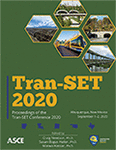Tran-SET 2020
Stabilizing Sandy Silt Soil with Fly-Ash Based RCA Geopolymer in Pavement Base Layers
Publication: Tran-SET 2020
ABSTRACT
Silty soils originally found onsite or borrowed can be problematic in nature particularly in its liquefied state and this may affect the service life of any pavement layer. Cement stabilized soil, using ordinary Portland cement (OPC), is traditionally utilized to stabilize such soils to enhance its strength. Clearly, several environmental issues have stemmed from the use of OPC wherein a more sustainable material with a low carbon footprint has generated lots of interest in present climes. In recent decades, fly ash has become more abundant in nature solely because of its constant disposal as a byproduct from industrial plants. However, when mixed with soil under alkali activation, it tends to form geopolymers and this has been studied to be at par or greater in strength than cement stabilized soil (CSS) and other chemical stabilizers. Therefore, this research proposes the use of fly-ash-based geopolymer with recycled concrete aggregates (RCA) as a stabilizer for sandy silt road base material. A low calcium fly ash was applied on sandy silt soil to obtain an effective mix that would enable soil to be stabilized for road base use. The fly ash-based soil geopolymer specimens were tested for unconfined compressive strength (UCS), resilient modulus (Mr), durability, and indirect tensile strengths. Results have shown geopolymer-stabilized sandy silt soil to have greater improvements in strength and durability as compared to CSS.
Get full access to this article
View all available purchase options and get full access to this chapter.
REFERENCES
1.
Abbasi, N (2011) The role of anions in dispersion potential of clayey soil. J Agric Eng Res 12(3):15–30.
2.
Abbasi, N, Nazifi, M.H (2013) Assessment and modification of shared chemical method for evaluation of dispersion potential of soils. J Geotech Geol. Eng. 31(1):337–349. https://doi.org/10.1007/s10706-012-9573-7.
3.
Afsharian, A.A, Abbasi, N, Khosrojerdi, A, Sedghi, H (2016) Analytical and laboratory evaluation of the solubility of Gypsiferrous soils. Civil Eng J 2(11):590–599.
4.
Abbasi, N, Bahramloo, R, Movahedan, N (2015) Strategic planning for remediation and optimization of irrigation and drainage networks: a case study for Iran. Agric Agric Sci Procedia 4:211–221. https://doi.org/10.1016/j.aaspro.2015.03.025.
5.
Rahimi, H, Abbasi, N (2008) Failure of concrete canal lining on fine sandy soils (A case study for Saveh Project). J Irrigation Drainage, ICID 57:83–92. https://doi.org/10.1002/ird.350.
6.
Sakr, M.A, Shahin, M.A, Metwally, Y.M (2009) Utilization of lime for stabilizing soft clay soil of high organic content. Geotech Geol Eng 27:105–113.
7.
Ji-ru, Z.H, Xing, C (2002) Stabilization of expansive soil by lime and fly ash. J Wuhan Univ Technol Mater Sci 17:4.
8.
Poonam, D.P, Yogesh, N.B, Patil, P.P (2004) Effects of Fly Ash Stabilization on Silty Soil, IOSR Journal of Mechanical and Civil Engineering (IOSR-JMCE) e-ISSN:, p-ISSN:, 06-11.
9.
Athanasopoulou, A. (2013) Addition of Lime and Fly Ash to Improve Highway Subgrade Soils. Journal of Materials in Civil Engineering, 26, 773-775. https://doi.org/10.1061/(ASCE)MT.1943-5533.0000856.
10.
Hossain, K.M., Lachemi, M. and Easa, S. (2006) Characteristics of Volcanic Ash and Natural Lime Based Stabilized Clayey Soils. Canadian Journal of Civil Engineering, 33, 1455-1458. https://doi.org/10.1139/l06-099.
11.
Abdi, M, Charkhyari, F (2010) Application of BOS Slug for stabilization of fine grained soils. In: 8th international congress of civil Engineering, Shiraz, Iran.
12.
Van Deventer, J. S. J. Opportunities and Obstacles in the Commercialisation of Geopolymers Properties, Geopolymers 2002 -Turn Potential into Profit. ISBN: 0975024205, Melbourne, Australia.
13.
Patimapon, S. H., L.S. Sukmak. Strength development in clay–fly ash geopolymer. Construction and Building Materials. 2013. 40(566-574), 11.
14.
Naik, T.R. and G. Moriconi. Environmentally friendly durable concrete made with recycled materials for sustainable concrete construction. Proceedings of International Symposium on Sustainable Development of Cement, Concrete and Concrete Structures, 5-7 October 2005, Toronto. pp 485-505.
15.
Asphalt Pavement Association of Oregon (APAO). Newsletter. Spring 2004.
16.
Factors Influencing Crack-Induced Tensile Strength of Compacted Soil." J. Mater. Civ. Eng., 315-320.
17.
Provis, J.L, G.C. Lukey, J.S.J Van Deventer. “Do geopolymers actually contain nanocrystalline zeolites?” A Re-Examination of Existing Results. Chemical Materials. 2005. 17(12), 3075–3085.
18.
Shuang, S.X., W. Q.Yuan, Z.X Ling, C. Frank, Discussion on properties and microstructure of geopolymer concrete containing fly ash and recycled aggregate Adv. Mater. Res. 2012. 450–451, pp. 1577-1583.
19.
Carlos, A. R, S. P. Arredondo-Rea, J. M. Gómez-Soberón, L. Jorge. Experimental study of XRD, FTIR and TGA techniques in geopolymeric materials, International Journal of Advances in Computer Science & Its Applications, 2014 (Volume 4: Issue 4).
Information & Authors
Information
Published In
Tran-SET 2020
Pages: 76 - 86
Editors: Craig Newtson, Ph.D., New Mexico State University, Susan Bogus Halter, Ph.D., University of New Mexico, and Marwa Hassan, Ph.D., Louisiana State University
ISBN (Online): 978-0-7844-8330-5
Copyright
© 2021 American Society of Civil Engineers.
History
Published online: Jan 12, 2021
Published in print: Jan 12, 2021
Authors
Metrics & Citations
Metrics
Citations
Download citation
If you have the appropriate software installed, you can download article citation data to the citation manager of your choice. Simply select your manager software from the list below and click Download.
